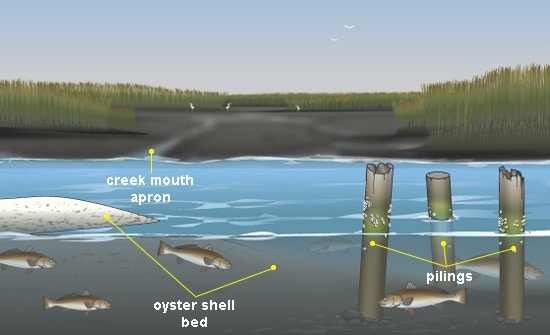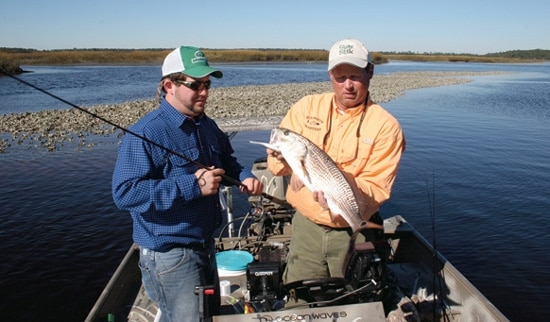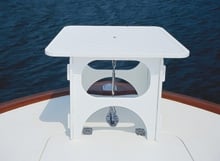
EBB AND FLOW: As tides fall, redfish pull out of inshore marshes and creeks. They will hold on low-tide aprons near creek mouths, around oyster bars and near other structure such as pilings.
Illustration: Pete Sucheski
Stalking redfish in shallow water is arguably the most exciting (and sometimes most effective) way of catching them. But tides must be high enough so anglers can motor, pole or wade back far enough onto flooded flats and coastal grass areas to find and catch feeding fish. In many places, ideal conditions occur only a few days per month-during full- and new-moon phases and stormy periods.
Georgia Captain Greg Hildreth has a better way. He fishes reds at low tide, and he showed me firsthand how his fishing system works.
One morning near Brunswick, Georgia, Hildreth, my son Eric and I wound our way up a feeder creek off Altamaha Sound aboard Hildreth’s aluminum skiff. Huge expanses of black muck and exposed oyster bars stretched between navigable water and spartina grass. To my conventional way of thinking, it was the worst possible time to be hunting redfish in shallow water.
“There are two or three schools of redfish here that feed on low-tide mud flats, and they do it year-round,” Hildreth said, moving to the poling platform. “They’re as predictable as any inshore fish can be-much more so than flood-tide reds, which will scatter back into creeks and sloughs.”
We didn’t look long before Hildreth spotted several wakes from cruising redfish. He poled the boat to intercept them, instructing Eric to send his weedless soft-plastic jerkbait toward the fish. A few twitches later a red pounced on the lure. I zipped a lure to the reds and hooked up, too.
Catching those fish roiled the water and disturbed the flat. But after we released the reds and got back into a stalking mode, Hildreth quickly found more cruising fish a short distance away. Again we fired lures, hooking, losing and catching more reds. The action continued over the next couple of hours.

TURN THE TIDE: Greg Hildreth, right, hoists a low-tide redfish taken near an oyster bar.
Photo: Bob McNally
Flats Fantastic
“When the tide floods, redfish schools push far back into little creeks and muddy pools,” says Hildreth. “A five-pound redfish can nose way back into awfully skinny water-so shallow I can’t follow it. I can only float my boat into those places during the highest tide. And the mud is so bad, it’s impossible to wade. That’s why low tide is the best time to stalk redfish in many coastal areas, and I’ve done it throughout coastal Georgia, South Carolina and in my native Alabama. I can consistently locate them any day, 12 months a year.”
The best places for sight-casting to low-tide reds feature large, apron-like flats with one to three feet of water (at full ebb tide), near feeder-creek mouths and back bays. Reds will muscle well up creeks and bays during flood water, but when they pull out of such spots during falling water, they hold on aprons waiting for baitfish, crabs and shrimp that get flushed out with a tide. Reds will remain here waiting for the next flood tide and then move in with the water to feed.
Consider what they are feeding on when making your lure selection. Attempt to match the size of the lure to the forage. The most important trait for a good low-water redfish lure is that it enters the water softly on the cast, so it doesn’t spook fish. Many lures qualify, including most streamer flies and popping bugs.
Soft-plastic jerkbaits, rigged weedless with little or no weight, are favorite lures used by experienced anglers.
Weather or Not
“Low-tide sight-casting for reds is very predictable, in almost any weather,” says Hildreth. “Strong wind is about the only time I can’t spot fish because it ripples the water, making reds tough to see. But bright, calm weather-spring, summer, fall and winter-you can locate and stalk redfish.”
The biggest schools of low-tide redfish are available from fall through early spring when Hildreth often sees pods of 50 to 100 redfish, most weighing five to 12 pounds. During warmer weather, the schools are still around-in the same predictable low-tide apron flats-but they hold fewer fish, often three to 15 reds.
“It’s one of the surest things I know in inshore fishing,” Hildreth says.
“I can bank on those fish being there 365 days a year.”
And what’s better than knowing where to find hungry reds twice a day?
Vantage Point

| |HIGH AND MIGHTY: A sturdy casting platform for any boat Photo: Dave Lear| Stand tall and get the drop on redfish and trout.
It’s tough to sight-fish when you can’t see into the water, but this casting platform from J.W. Austin Industries ($195) solves that problem. Made of UV-resistant Starboard with a nonskid, self-draining deck, this lightweight (12 pounds) platform is great for flats or bay boats. J.W. Austin Industries; (321) 723-2422
– Dave Lear









